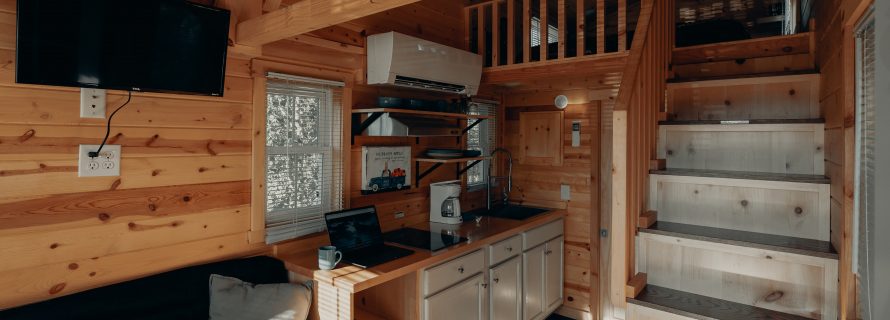4 Ways to Prepare Your Tiny Home For Any Weather

Tiny homes have developed a cult following in the past few years. Instead of putting their entire life’s savings into a down payment on a home, or throwing away money every month on an expensive apartment, more people are deciding to do more with less. The tiny house movement helps people save money, lower their environmental footprint, and limit mindless shopping.
For minimalists, the tiny home movement is a dream come true. But many people buy their new mini home without making sure it’s winter-ready. Get your tiny home ready for any type of weather by taking care of these essentials.
Heating & Cooling
One of the upsides to having a tiny home is that there’s less square footage you have to warm up and cool down. This means you start to see energy savings almost immediately. Space heaters, gas or electric fireplaces, window air conditioners, or simple oscillating fans are great options for those looking for HVAC on the cheap and as secondary forms of heating/cooling. But for most tiny homes, mini split systems will be your best option.
Mini split systems provide both heating and cooling capabilities in a compact setting, are energy efficient, and don’t require ductwork or extensive installation. They are a bit expensive, but will save you money over time.
More tiny homes on the market also have smart home capabilities built in that can connect to your mini split system. Since most AC and heating systems these days have WiFi and smart thermostat capabilities, integrating those into your tiny home’s HVAC can add immense value to your space and streamline your HVAC system.
Windows
Your tiny home’s windows can make a big difference in your indoor temperature throughout the year. If you’re building your tiny home from scratch, adding as much natural lighting as possible is important. Natural lighting can help make your tiny home feel more spacious, but they’re also great for warming up your space in the wintertime.
Large windows don’t just allow light to enter your home, it allows the warmth from that light to come in as well. That light heats up your space quickly when you have a smaller square footage, which helps lower your heating costs and energy footprint. If the summers get particularly hot where you live, make sure you have blinds or thick shades to block out the heat.
Double glazed windows are the favorite for full-sized houses, but can add a lot of unnecessary weight to portable tiny homes that need to be towed. But if you’re going to have a permanent location, they’re a great option that will keep your home insulated and warm during the winter.
Humidity
Remember how the inside of your car can get humid and fog up the windows in the winter? The exact same thing happens to tiny homes during cold weather. Because tiny homes have lower square footage, even the moisture in your breath can build up over time and cause damage to the home.
Proper ventilation and installing a dehumidifier will keep your tiny home’s interior safe and comfortable. In the summer, you can simply open windows to get that ventilation. But for colder seasons when you want to conserve heat, dehumidifiers will be your best option. Using a dehumidifier in your tiny home will protect the space from mildew, water damage, wood rot, and other humidity issues.
Severe Weather
Depending on where you decide to set up your tiny home, you may be more exposed to severe weather conditions. When bad weather happens, traditional homes have their heavy weight and structural reinforcements to help them get through storms relatively unscathed. But tiny homes are much more vulnerable.
If you live in areas that receive a lot of rain or where monsoons/hurricanes happen regularly, make sure you invest in hurricane tiles and a quality drainage system to avoid flooding. You’ll also want to invest in an anchoring system to keep your home from toppling over if heavy winds are a common problem in your area. Since tiny homes and tiny homes on wheels (THOWs) often don’t comply with building codes, you want to make safety a top priority. When you know a storm is on the way, having an emergency plan in place will help keep you and your tiny home safe.
Bottom Line
Compromising on size doesn’t have to mean compromising on comfort. Your tiny house can be enjoyable in all weather, hot or cold. The key to a successful season is to be prepared and avoid surprises. Whether you follow one of these tips or all four, give yourself the possibility to be as comfortable as you can be. Not only will your tiny house appreciate it, but you will too!
About The Author: Molly is a devoted mom, passionate writer, and budding solopreneur. As a mother of two boys, she hopes to inspire parents to stress less and enjoy the big, beautiful world a little more.
Photo by Clay Banks on Unsplash
- Additions and New Construction
- All Exteriors
- Alterations
- Basements
- Bathrooms
- Customer Service
- Customer Stories
- Decks
- Design & Planning Show
- DIY
- Doors
- Educational Resources
- Extreme Makeover Home Edition
- Fashion Show
- General Remodeling
- Green Living
- Handyman Home Services
- Home Decor
- Home Entertainment
- Home Improvement
- Home Improvements
- How to Tips
- In The Community
- Kitchens
- Off-the-Wall Remodeling Stories
- Remodeling
- Resources
- Roofing
- Siding
- Social Media
- Sunrooms
- Tips & Tricks
- Trends
- Windows

